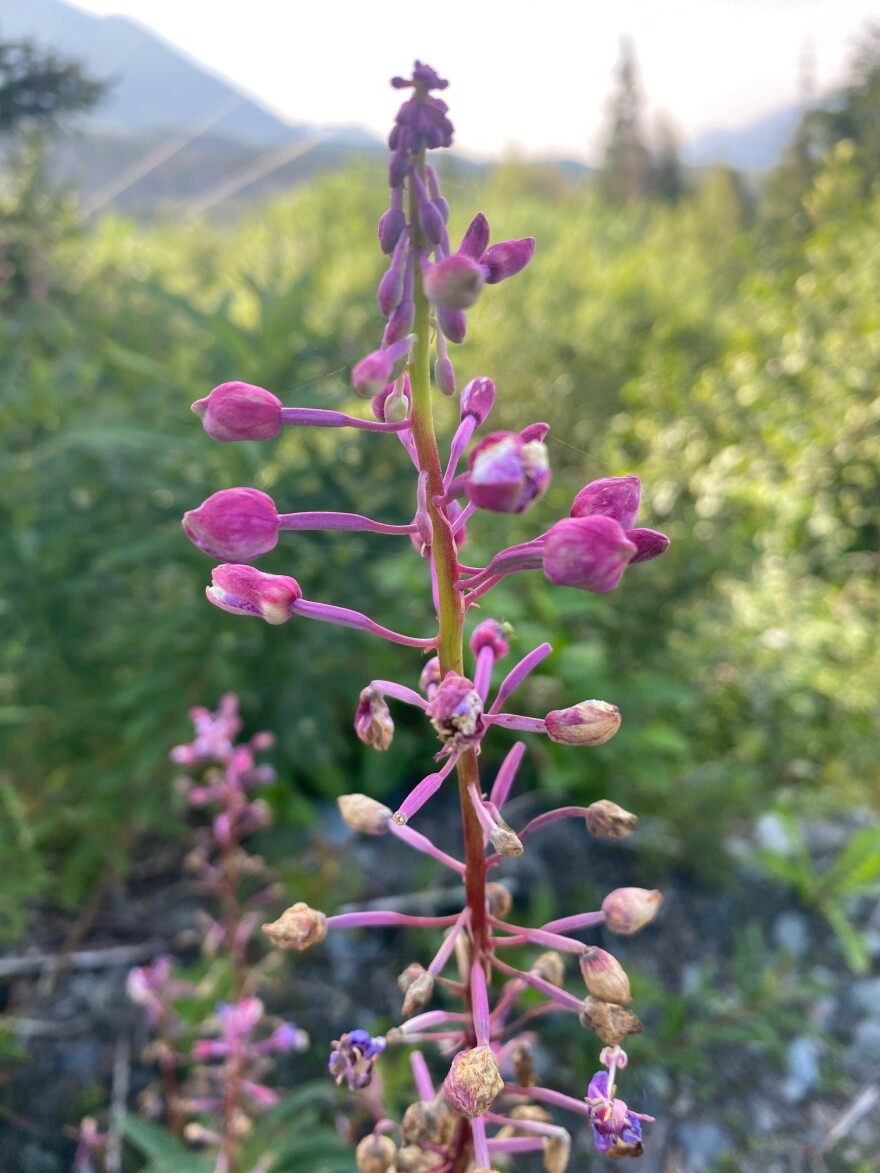As the Alaska adage goes, you count down to the end of summer by fireweed blossoms climbing their stalks. Except this year in Southcentral, where the lack of fireweed blossoms might be yet another indication of a summer that wasn’t.
Typically, by the end of August, roadsides, hillsides and anywhere wild grasses grow are awash in the distinctive pinkish purple of native fireweed flowers. This year, there are plenty of fireweed plants in all the usual places but few are flowering.
Lots of plants have been behind their regular growth schedule due to the cold, wet weather that has predominated this summer. But it’s looking more and more like the fireweed isn’t going to bloom at all.
“Yeah, that’s what I’ve been thinking. I don’t have any good data to be able to back that up. But it does seem like that’s probably what happened just because it’s been so widespread,” said Alex Wenninger, an integrated pest management specialist with the University of Alaska Fairbanks Cooperative Extension Service, based in Anchorage. She’s been keeping an eye on fireweed this year because of a tiny fly that’s infiltrating fireweed buds and causing them not to open.
Normal fireweed buds are long and skinny but the fly causes the buds to gall, turning them fat, round and swollen. Galled buds don’t open, but if you peel them apart, you might see tiny fly larvae inside.
Wenninger has gotten reports of fireweed gall from Fairbanks to the Kenai Peninsula. She’s collecting samples of the fly to send to an expert to see if this is a newly described fly, something with a previous record in Alaska or if it’s invasive.
But this isn’t the fly in the ointment of the lack of fireweed flowers overall.
“They’re not the cause of the fireweed not producing blooms. They’re just taking advantage of some of those blooms that did happen to be produced on some of those flowers,” Wenninger said.
Justin Fulkerson is lead botanist and Dr. Matt Carlson is director of the Alaska Center for Conservation Science at the University of Alaska Anchorage. They’ve been discussing fireweed in their office. Fulkerson says timing of fireweed blooming can vary year to year. For most of the last 10 years, fireweed started blooming around July 4 in Southcentral. Last year, it bloomed about two weeks early. This year, fireweed doesn’t seem to be blooming at all.
Fulkerson referenced a recent study showing cursory evidence that fireweed has a threshold of warm growing days that must be reached to trigger flowering. That might not have happened this year. Carlson thinks fireweed might not have developed fast enough. He says air temperature can influence the speed of development — in this case, with plants setting buds slower than normal. Bud maturation might have aborted as plants recognized shortening days. Instead of expending energy on flowering, plants start moving nutrients to their roots and hardening in preparation for winter.
The lack of the iconic Alaska late summer blooms is disappointing for fireweed photographers and those who gather blossoms for jelly and other products. But it’s devastating for species that depend on fireweed — bees.
Sarah McElrea runs Sarah’s Alaska Honey on Gaswell Road, near Soldotna. She says this has been a disastrous year for beekeeping.
“It’s been pretty pitiful for beekeepers, at the very least across the peninsula. I was kind of holding out hope that (fireweed) would bloom late. But honestly, what is blooming has just got a few little fairly pitiful blooms and they’re just kind of shriveling up before they even open, for the most part,” she said.
McElrae says clover and dandelion did well this year. But bees couldn’t make much use of it because it was too rainy.
“They can’t get out and forage in anything more than like a light trickle. And so even though we had this other stuff blooming the bees just basically sat inside the hives and were hungry,” she said.
Any honey produced she’s fed back to the bees to keep them from starving. With that gone, she’s now feeding them sugar syrup. McElrae would usually be harvesting and packaging honey to sell on her website and at markets throughout the fall and winter. She doubts she’ll have enough honey to sell this year to even cover the costs of the bees.
“It has been one of, if not the worst beekeeping years for me in 23 years of doing it here on the peninsula,” she said.
As for the fireweed gall, Wenninger is still looking for reports to gauge how widespread it is across the state. Send pictures of affected blossoms — what few blossoms there may be — to akwenninger@alaska.edu.




